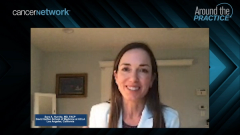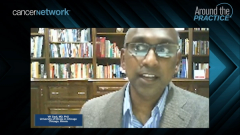
Treatment Strategies for Relapsed/Refractory HER2+ MBC
Episodes in this series

Adam M. Brufsky, MD, PhD: Let’s move on to the next polling question. This has been great so far. There’s a lot of good stuff. What factors are important when considering a treatment approach for a patient with HER2 [human epidermal growth factor receptor 2]-positive metastatic breast cancer that has progressed on greater than 2 lines of prior therapy: the nature and depth of progression, duration of response to previous therapy, the mechanism of action, exposure to certain molecules in the early stage setting, tolerance to previous therapy, sites of progression, or all?
This is the real meat of the matter, these last 15 or 20 minutes we have in this program. We have 3 regimens that are now approved for this. The question people always ask is, “Which one do you do, and how do you sequence them?” We already started talking about HER2CLIMB. We now have DESTINY-Breast01, which is trastuzumab deruxtecan. We also have NALA, which is neratinib and capecitabine.
Neil M. Iyengar, MD: Adam, we also have margetuximab.
Adam M. Brufsky, MD, PhD: Let’s take a minute and talk about margetuximab. My understanding of the [SOPHIA] trial, which is margetuximab vs trastuzumab in whatever line—greater than first line or something—is that they had about a 1.9-month PFS [progression-free survival] and no OS [overall survival] benefit, and the FDA approved the drug.
Sara A. Hurvitz, MD, FACP: It was the SOPHIA study.
Adam M. Brufsky, MD, PhD: SOPHIA. I was thinking of the wrong study—HERITAGE is a biosimilar. You’re right, it’s SOPHIA. The thing is that they approved it. It’s great. I want to have more stuff, but I don’t know, what do you guys think? You brought it up, VK, so I’ll start with you.
VK Gadi, MD, PhD: I’m also surprised by the approval. You and I have discussed this before. It’s a drug that works specifically by optimizing how the immune system engages the monoclonal antibody to deliver better ADCC [antibody-dependent cellular cytotoxicity]. Specifically there’s some NK [natural killer cell] targeting of the antibody that happens based on polymorphisms that exist naturally. This molecule has now been optimized to capture more of the population so that you get a better immune response. That’s the fundamental theory. It makes a lot of sense. Preclinically, it looks very active in the phase 1/2 studies. There are clearly exceptional responders, but here we do a phase 3 study, and it’s underwhelming.
If all things are equal and cost is not that different between 2 monoclonal antibodies, you can envision substituting this in later lines of therapy after people have seen trastuzumab deruxtecan and even the tucatinib. I can envision myself using this for patients where I’m going to pair it with Navelbine or eribulin or something like that, as they did on the study. I agree, I’m underwhelmed. The idea that this could somehow move up multiple lines of therapy to become integrated in other lines is a big lift for that molecule. Those are my 2-minute thoughts on it.
Sara A. Hurvitz, MD, FACP: I would add2 quick things. First of all, if it’s inciting the immune response, shouldn’t we be using it in earlier-line settings like first or second line? Also, the benefit was restricted to patients who are F [allele] carriers, where there began to be a little bit of a survival benefit of around 5, 6, or 7 months. It wasn’t statistically significant. Shouldn’t it have been approved for just those patients, the 84% or so who are F carriers? That’s what irked me about it.
Adam M. Brufsky, MD, PhD: Yes, it’s really interesting. I agree with you. The theory now is the longer you go, the more immunosuppression you get, so it makes perfect sense to do it early. There was a cool neoadjuvant study. It’s MCHP [margetuximab, carboplatin, trastuzumab, pertuzumab] instead of TCHP [docetaxel, carboplatin, trastuzumab, pertuzumab]. That will be kind of interesting. That’s where I think this is going to shine if it shines at all.
Let’s talk a little bit about DESTINY-Breast01. The data are spectacular. You now have a drug that has a 16.5-month PFS and an OS that was finally 24 months—I think it’s probably longer because of all the censoring. It was a phase 2 trial. We’re all awaiting DESTINY-03 and DESTINY-04 to help us figure out what’s really going on here—the randomized trial. On the other hand, we have NALA, which is another TKI [tyrosine kinase inhibitor]. It’s very similar but with a slightly different patient population and without trastuzumab. How do you choose which one to use? That’s the question most people are asking. We could spend 5 or 6 minutes on this, and we’ll do a case where it will become somewhat clear. Sara, how do you make the choice at this point between all these regimens?
Sara A. Hurvitz, MD, FACP: I’m not using neratinib very much. The toxicity profile is extremely tough for patients to deal with. It did beat lapatinib with capecitabine. The biggest reason I’m not using neratinib is that we now have tucatinib. Tucatinib is more HER2 selective and better tolerated. We don’t have evidence that neratinib works well after tucatinib, which is where I would place it. We need evidence of whether neratinib works in brain metastases and in systemic metastases post-tucatinib. If it does, that’s probably where I’ll use it.
I’m a big fan of trastuzumab deruxtecan—very exciting phase 2 data, as you mentioned. ILD [interstitial lung disease] has to be considered, especially in the COVID-19 [coronavirus disease 2019] era where they can mimic one another. It happens around 15% of the time. We have to have our eye on the ball and watch those CT scans for asymptomatic ground glass opacities. That’s the major downside, but I do think based on its activity, it’s probably going to beat the lapatinib/trastuzumab plus capecitabine control arm.
Adam M. Brufsky, MD, PhD: I would agree with that. Neil, what do you think? In terms of the ILD, the issue here is that we always would blow off these ground glass opacities. Everybody had them. Schmutz is what we used to call it, right? You can’t blow that off anymore. What’s your experience at Memorial [Sloan Kettering Cancer Center] with ILD for this? Has it been relatively similar to what everybody else is seeing: a couple percent to 5% or 6%?
Neil M. Iyengar, MD: Yes and no. As you said, it is a serious consideration, especially when we’re talking about earlier lines of therapy. The experience here has been consistent with the published experience. What is highly concerning about it is how rapid it can be in terms of patient deterioration. This is anecdotal evidence, but I had a patient on the DESTINY phase 2 study who developed ILD and subsequently died of ILD. She was in our ICU [intensive care unit] and we threw everything at her—immunosuppressants, steroids, etc. It was such a rapid progression in terms of her pulmonary decompensation.
I’m very weary of ILD. Obviously, that has to be weighed with how successful the drug is in terms of treatment response and cancer response. It is undoubtedly a successful drug and a useful treatment option, but we have to watch the lungs very carefully. The problem is that we don’t have the data in terms of how to risk stratify. I know multiple groups are working on this right now. In terms of my clinical practice, I order baseline pulmonary function testing—not so much to risk stratify or decide whether I should use the drug, but to help me should the patient develop pulmonary symptoms and I’m trying to differentiate the severity and what the etiology might be.
To answer your question, I do think our experience is consistent with the published experience. When we’re trying to make a treatment decision where this drug, trastuzumab deruxtecan, may be an option among a variety of other drugs, it is certainly something that I bring up and discuss.
The other piece I’ll add is that I think that the tumor response to trastuzumab deruxtecan was quite impressive. We all remember seeing the waterfall plot that was shown. That’s quite impressive. Although we shouldn’t be comparing across trials, when you compare it to other tumor responses, for example, in HER2CLIMB, it perhaps isn’t as striking. One thing that gives me pause is in the follow-up data where we see progression-free survival and overall survival. The activity was impressive but perhaps not as impressive as I might have predicted with the tumor response data. That makes me even more likely to consider the context in which we’re prescribing the treatment. In other words, to make sure I understand the patient’s risk factors, if she developed prior lung disease, if she has high COVID-19 risk factors—for example, age, and clinical setting, and geographic setting, and so forth. I think these are all very important when we consider whether we can use this drug.
Adam M. Brufsky, MD, PhD: Great. VK, do you have any comments on all these 3 agents and how you would use them?
VK Gadi, MD, PhD: I completely agree with what’s been said. In general, I’m thinking about this drug for the deruxtecan molecule as something that I’m probably going to use in my personal practice after they’ve seen tucatinib. That’s just a general statement. That’s not always going to be the case, but that’s where I’m going to position it. The NALA study is intriguing. I’m open to the idea of trying a broad TKI after a very precise TKI, so neratinib after tucatinib. I’m open to that concept, but I would obviously love to see data around that.
What worries me is that we have all these patients who have been diagnosed with COVID-19. Many of them get symptomatic and that’s easy to call. But what about those asymptomatic patients who may have a small decrease in their lung function that’s not clinically apparent? What’s the risk to that patient when we then come and layer on something like this deruxtecan molecule? I know that’s a unique situation to the time we’re in, and maybe that won’t matter 5 or 10 years from now, but it matters right now. I have a lot concerns about exposing patients who may have subclinical lung injury, widespread lung injury from something like COVID-19, and then coming back in with a molecule like deruxtecan and what could happen in that scenario. All of us we need to be on high alert about using this molecule in the current time.
Adam M. Brufsky, MD, PhD: Part of the problem is we don’t really know the mechanism of the ILD. That’s part of the issue. I think it’s probably the deruxtecan, like you said, and we just don’t know. It’s weird. It’s totally idiosyncratic. It could happen 2 weeks after starting, or it could happen months after starting. That suggests there’s some sort of external insult that happens that triggers it. What that is I don’t think anybody knows.
Transcript edited for clarity.
Newsletter
Stay up to date on recent advances in the multidisciplinary approach to cancer.
































































































